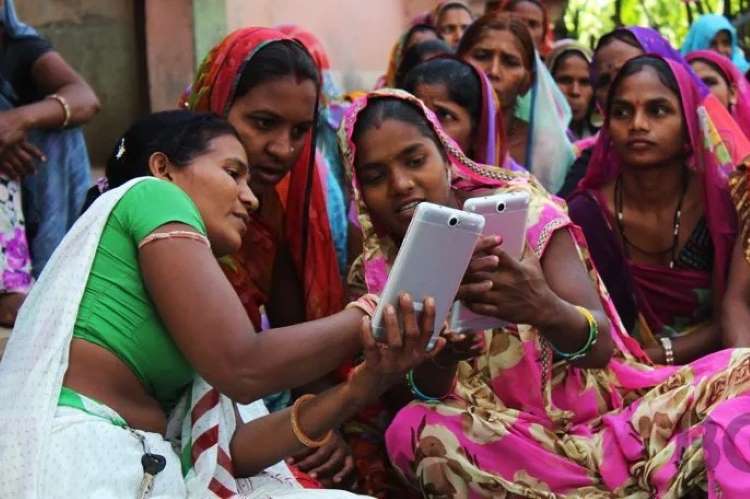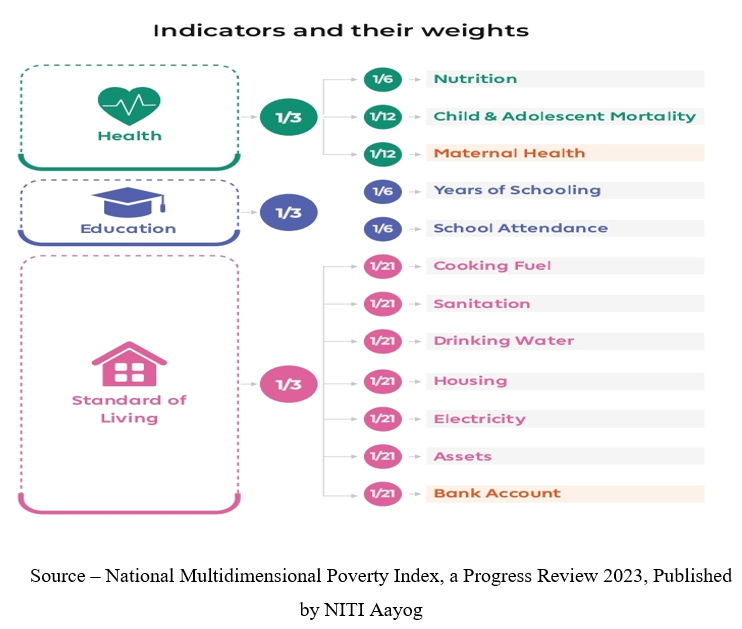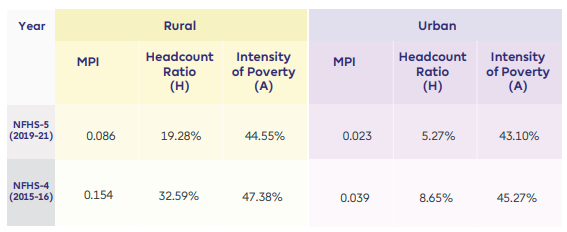
Multidimensional Poverty Index: Despite its great achievements since Independence, India is struggling to eradicate poverty and to improve the lives of its 1.4 billion citizens. The country has adopted a multidimensional approach to measure poverty on the lines of the Global Multidimensional Poverty Index. The MPI is a robust tool that goes beyond conventional income-based measures, delving into the various dimensions of poverty that affect people’s lives. It assesses poverty across three essential dimensions: health, education, and standard of living.
The MPI considers a range of indicators such as infant mortality, years of schooling, access to clean water, and sanitation. By measuring poverty across multiple dimensions, the MPI provides a more comprehensive and nuanced understanding of poverty compared to income-based measures alone.
Health dimension: The health dimension of the MPI measures poverty in terms of access to basic health facilities and the associated consequences. Indicators used are the percentage of children who die within the first 5 years of birth, share of underweight children, and the share of households without sanitation facilities.
Education dimension: The education dimension of the MPI assesses poverty in terms of access to education and educational outcomes. It takes into account indicators such as the percentage of school-age children not attending school and of school-age children attending school but not at appropriate grade levels.
Standard of living dimension: The standard of living dimension of the MPI measures poverty in terms of access to basic services and assets. This includes indicators such as percentage of households without access to electricity, sanitation facilities, clean drinking water sources, households living in inadequate conditions, without access to clean cooking fuel, those without access to items like radio, television, telephone, bicycle, or motorbike, and households without a bank account.
Each of these indicators is given equal weight within its respective dimension, and the dimensions are also equally weighted in the overall MPI. This means that every indicator contributes equally to the overall MPI score, and each dimension holds equal importance in determining an individual’s level of poverty.

READ I NPA writeoffs will hurt economy, RBI needs to be transparent
Formula of multidimensional poverty index
The Multidimensional Poverty Index (MPI) is calculated using the Alkire-Foster methodology, a universally recognized framework for measuring multidimensional poverty. This methodology identifies people as poor or not based on a dual-cut-off counting method. The formula for calculating the MPI is as follows: MPI = H x A, where:
H is the percentage of people who are multidimensionally poor
A is the average intensity of poverty among the poor
To calculate H, the Alkire-Foster methodology first identifies people who are deprived in at least one-third of the weighted indicators within each dimension. These people are considered multidimensionally poor, and the percentage of people in this category is calculated as the number of poor individuals divided by the total population.

To calculate A, the Alkire-Foster methodology assigns a deprivation score to each person based on the number of indicators in which they are deprived. The deprivation is measured in the range of 0 to 1, with 1 indicating the highest level of deprivation. The deprivation scores are then aggregated for all multidimensionally poor individuals, and the average deprivation score is calculated. This average deprivation score represents the average intensity of poverty among the poor.
The final MPI score is the product of H and A, reflecting the overall level of multidimensional poverty in a given population. This score also ranges from 0 to 1, with 0 indicating no poverty and 1 indicating extreme poverty.
Importantly, the Alkire-Foster methodology allows for flexibility in the choice of indicators and weights, tailored to the context and priorities of the country or region being measured. This customization enables the MPI to accurately reflect the specific dimensions of poverty relevant in a given context. However, it necessitates a rigorous and transparent process for selecting indicators and weights to ensure the resulting MPI is robust and comparable across different contexts.
Overall, the Alkire-Foster methodology and the MPI offer a robust tool for measuring poverty that surpasses traditional income-based measures. By considering multiple dimensions of poverty, the MPI provides a more accurate and holistic measure of poverty, empowering policymakers and development practitioners to design more effective poverty alleviation programs.
Usefulness of MPI
The MPI provides a more holistic picture of poverty by considering multiple dimensions, unlike income-based measures alone. Recognizing that poverty extends beyond income, the MPI also encompasses access to basic services, assets, health, and education outcomes. This comprehensive understanding equips policymakers and development practitioners to design more effective poverty reduction programs.
India has employed the MPI since 2015 to measure and address poverty at the national and subnational levels. The second National MPI report, released in 2018, analyzed poverty trends and patterns across the country. Notably, India has made significant progress in reducing poverty since the baseline report in 2015. The share of people living in multidimensional poverty has fallen from 55% in 2015 to 28% in 2019. Nevertheless, the report underscored persistent inequalities and disparities among states and social groups, indicating that considerable efforts are required for poverty alleviation.
India has launched several initiatives to reduce poverty and improve citizens’ lives. The Global Initiative on Reducing Poverty and Inequality launched in 2019 in partnership with the UNDP supports poverty reduction efforts by providing technical assistance, sharing best practices, and promoting knowledge exchange. India, a founding member of GIRG, actively participates in its work.
Another significant initiative is the Aspirational Districts Programme, launched in 2018 to accelerate development in the country’s most disadvantaged districts. The program focuses on enhancing basic infrastructure, healthcare, education, agriculture, water resources, and financial inclusion.
Multidimensional Poverty Index is a powerful tool to understand and analyse poverty across various dimensions. India’s adoption of the MPI has provided valuable insights into poverty trends and has been instrumental in shaping effective poverty alleviation strategies. The focus on multiple dimensions of poverty, helps India in its efforts to improve the lives of its citizens.
(Dr Prashant Pareek is Assistant Professor and Dr Neha Sharma is Director at Shanti Business School, Ahmedabad, Gujarat.)

